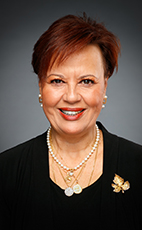44th Parl. 1st Sess.
December 12, 2023 10:00AM
- Dec/12/23 5:39:56 p.m.
- Watch
Madam Speaker, I am sorry I was not loud enough the first time.
I was wondering aloud if, when the leader of the Conservative Party decides to get his first job outside politics, he will be a—
38 words
- Hear!
- Rabble!
- add
- star_border
- share
- Dec/12/23 5:40:08 p.m.
- Watch
That is not a point of order, but a point of debate.
The hon. Leader of the Opposition.
18 words
- Hear!
- Rabble!
- add
- star_border
- share
- Dec/12/23 5:40:11 p.m.
- Watch
Madam Speaker, so says the guy who has been living off a parliamentary paycheque since he was born, because his dad was a member of Parliament. He still is.
The reality is that the member for Kings—Hants was among those Liberal MPs banging on the door, begging the Prime Minister to relent on his carbon tax.
The Prime Minister, shaking on the ground, finally agreed to relent. Out he walked to an unannounced, unscheduled press conference, without any written materials. It was not even in his itinerary moments earlier. He announced that he would put in a temporary three-year pause, but just for some people, in regions where his poll numbers were plummeting and his caucus was revolting. There is now that temporary pause on the carbon tax, a carve-out.
His environment minister said there would be no more carve-outs. There already have been. For example, there is no carbon tax on the industrial sector in Canada. It has a carve-out. There is no carbon tax on large cement plants or concrete factories—
180 words
- Hear!
- Rabble!
- add
- star_border
- share
- Dec/12/23 5:41:24 p.m.
- Watch
The hon. member for Jonquière is rising on a point of order.
14 words
- Hear!
- Rabble!
- add
- star_border
- share
- Dec/12/23 5:41:29 p.m.
- Watch
Madam Speaker, I do not know if there is a problem with the interpretation, but this is very confusing. The member is talking about a documentary and a carbon tax that does not apply. I do not know whether it is a problem with the interpretation, but perhaps the Leader of the Opposition could speak a little more slowly. It is difficult for the francophones to understand what he is talking about.
72 words
- Hear!
- Rabble!
- add
- star_border
- share
- Dec/12/23 5:41:47 p.m.
- Watch
Madam Speaker, this is not a language issue. It is just that the Bloc Québécois does not understand common sense. That is the problem.
28 words
- Hear!
- Rabble!
- add
- star_border
- share
- Dec/12/23 5:41:58 p.m.
- Watch
Madam Speaker, can the member for Carleton tell us if he will be continuing, so I can ask my question when he actually has a chance to re-engage on this?
31 words
- Hear!
- Rabble!
- add
- star_border
- share
- Dec/12/23 5:42:40 p.m.
- Watch
Madam Speaker, I would ask for the unanimous consent of the House to let the leader of the official opposition finish this wonderful speech, which is teaching us such great and marvellous things.
33 words
- Hear!
- Rabble!
- add
- star_border
- share
- Dec/12/23 5:42:51 p.m.
- Watch
Does the hon. member have unanimous consent?
Some hon. members: No.
11 words
- Hear!
- Rabble!
- add
- star_border
- share
- Dec/12/23 5:43:06 p.m.
- Watch
Madam Speaker, I rise on a point of order. I truly believe if you ask again, people would be so excited to hear the end of the story from the member for Kings—Hants.
Some hon. members: No.
39 words
- Hear!
- Rabble!
- add
- star_border
- share
- Dec/12/23 5:43:39 p.m.
- Watch
Madam Speaker, I am glad to rise on Motion No. 96.
I would not mind ceding my time to the hon. Leader of the Opposition so I could hear him speak more about the fall economic statement, but we are in Private Members' Business, and I do need to speak to this.
The last time I spoke to this, I spoke to the goodwill and good nature of what this motion represents. I also mentioned I met with the International Association of Fire Fighters. This is an issue. It is an issue that needs to be addressed, but what I spoke about is the need to get this to committee, which is how we make decisions around this place.
Private Members' Business, even with a motion as good-natured and as good willed as this, really does not have the effect or authority that committee business would have. What I mean by that is that we would get everybody in. The committee could, through its work, have stakeholders come in, including the International Association of Fire Fighters, the Canadian Airports Council and the International Civil Aviation Organization so we could all get as much information as we could to make an informed decision, not only on the status of current firefighting capabilities at airports, and how that relates to safety and other issues, but also on what the impact of that would be on costs.
A critical component to this is getting all sides of this issue to the committee table and having a proper and informed debate with lots of opportunities to ask questions and get answers. This is a critical component to where we want to go with this.
In fact, yesterday at the Standing Committee on Transport, Infrastructure and Communities, our shadow minister for transport, the hon. member for Chilliwack—Hope, presented a motion to committee to study this very issue. I will read into the record what his motion proposes.
He moved:
That the committee undertake a study on Aircraft Rescue and Fire Fighting at Airports and Aerodromes (Canadian Aviation Regulations, Section 303) allocating a minimum of three meetings to this study to hear from witnesses that include the International Association of Firefighters, the Canadian Airports Council and other interested parties, and that the Committee report its findings to the House.
That would be the proper format and venue for this issue to be studied. The member for Chilliwack—Hope is proposing to committee that we have up to three meetings and invite all of the stakeholders in, including the IFF, of which I am a former member, and the Airports Council. I would suggest having the International Civil Aviation Organization come in to talk about safety. We could have Transport Canada at that meeting. We could have government officials at those meetings to really properly vet this out and hear from all sides and, therefore, make an informed decisions.
Private Members' Business is an opportunity for members to propose legislation and propose motions. While I certainly see the value in what the member is proposing in his motion, it requires study. I do not think one would find an argument from the International Association of Fire Fighters, the Airports Council or other stakeholders such as the International Civil Aviation Organization that this issue needs to be properly studied.
I know the International Association of Fire Fighters has done a study on this. At committee, it could come in front of committee to argue its points. We would then have committee members write a report that would come back to Parliament to be endorsed by Parliament in its entirety. Only then, when all of the stakeholders have been to the table and all of that information has been proposed, and a report has been written by our eminently qualified analysts, could a suggestion of this magnitude and recommendations of this magnitude be made, knowing all of the facts.
While I appreciate and respect the work the International Association of Fire Fighters has done on this, we do need to hear from others and hear about the impact this is going to have on not only service but also costs. We have talked about that.
I know there is a number floating around that it could work out to a few dollars per airline ticket as a surcharge, and I would submit we may even have the airlines come in to talk about the impact that might have. I know there have been recent reports through the UN and International Civil Aviation Organization that suggest that safety at Canada's airports is not as robust as it should be. Perhaps we could have the authors of those reports come to committee as well.
I do think it does require a more fulsome study, other than just passing a motion here in the House of Commons. Yesterday, the member for Chilliwack—Hope proposed a motion at the transport committee. I hope every single member of the transport committee would look at that motion and understand what the intent is. It is to have everybody come in, talk about this and provide their input, and then have that committee issue a report to Parliament, which we could debate in a more fulsome manner.
Sometimes, through private members' business, we see a lot of different motions come forward. If we want something that is going to have some teeth, if we want something that is truly going to put forward the safety issues that the firefighters have identified, then we need a committee to study this further and bring all these parties to the table.
I appreciate the work everybody has done.
945 words
- Hear!
- Rabble!
- add
- star_border
- share
- Dec/12/23 5:50:05 p.m.
- Watch
Madam Speaker, we are considering Motion No. 96 today because there are some very significant shortfalls in Canada's firefighting regulations. I would like to name two of them, which are cited in the motion.
The regulations fail “to specify rescue as a required function of airport fire fighters”. The regulations require “only that fire fighters must reach the mid-point of the furthest runway in three minutes rather than all points on operational runways within that time period”.
The motion is clear.
[I]n the opinion of the House, the government should, without delay, ensure that the Canadian Aviation Regulations reflect airport rescue and firefighting standards published by the International Civil Aviation Organization, specifically by
(i) giving fire fighters at Canada's major airports the mandate and resources necessary to reach the site of a fire or mishap anywhere on an operational runway in three minutes or less,
(ii) specifying that a required function of fire fighters be the rescue of passengers.
It is about the recognition of rescue.
This is an important motion. We are in the second hour, and this motion will have to be voted on. The important thing to remember is that we must act without delay to resolve these situations and comply with standards.
It is too bad that the parliamentary rules do not allow us to acknowledge the presence and birthday of Alexandre Bertrand from the Aéroports de Montréal Fire Service, who is here with us in the House today.
256 words
- Hear!
- Rabble!
- add
- star_border
- share
- Dec/12/23 5:52:15 p.m.
- Watch
I am sorry, but I must remind the hon. member that we cannot mention the presence of other people in the House.
22 words
- Hear!
- Rabble!
- add
- star_border
- share
- Dec/12/23 5:52:22 p.m.
- Watch
Madam Speaker, I broke the rules. I wanted to acknowledge him because the Aéroports de Montréal Fire Service recognizes in this motion a unanimous desire to modernize the Canadian aviation regulations. It is urgent. They say this is a sincere and shared desire to improve safety for both firefighters and passengers. I also want to acknowledge my colleague from Mirabel for his work on this file and for his exemplary representation in a horrific tragedy that unfolded at the Mirabel airport. I think it is high time the federal government aligned the Canadian aviation regulations with international standards when it comes to rescue and firefighting at airports.
Yes, the motion reiterates the International Association of Fire Fighters' demand. Their position is based on ICAO standards, which recommend that all points on airport grounds be reachable within three minutes. The motion would also authorize intervention right in an aircraft, which is not currently allowed. Like a tragedy, this motion shows passengers and the public just how out of date the standards are and the extent to which existing rules in Canadian airports are unsafe and not in compliance with the regulations. The Montreal airport firefighters made that abundantly clear. It is time to take action.
The International Civil Aviation Organization, ICAO, is a United Nations agency that enables member states to co-operate on international civil aviation matters. ICAO's head office is in Montreal, Quebec. The organization really puts Quebec on the map. This is interesting because, as the organization's headquarters, Montreal should be a model of air transportation safety, not an example of obsolete federal regulations. Fire fighting services are key to an airport's safety program. An airport is only as good as its focus on safety.
According to the Aéroports de Montréal firefighting unit, three minutes is how long a plane can withstand a fire before it melts the fuselage and spreads from one end to the other on the inside. At the moment, regulations require airport firefighters to reach the middle of the furthest runway within three minutes. Clearly, this cannot work. If the core mission is to save lives and ensure safety, we are far from achieving that goal. It is high time that things changed. Just imagine for a moment being a passenger. Many of us in the House have to travel by air regularly. Let us imagine that our plane is on fire. What do we expect? We expect to be rescued immediately and kept safe. That is also what firefighters want. That is what they are supposed to do.
It is unconscionable that firefighters at an airport like Montreal's cannot perform the initial rescue on board an aircraft. This is currently the case under federal regulations. There is no valid reason why firefighters at major Canadian airports should not be responsible for performing this rescue. I would go even further in this debate. I would say that it is a problem that relates to recognizing the work of airport firefighters, a problem recognizing that firefighters have the skills, the qualifications and the mission to do their job. I would say they are heroes. The Bloc Québécois will certainly support this motion because it is time to modernize Canada's aviation regulations, which date back to 1996.
The regulations have not been reviewed in 30 years. We should not have yet another example of federal regulations—because there are other situations where regulations have not been reviewed in other fields for many years—where outdated rules from a long-gone era are still being used and fail to support the vital security and rescue mission we have at our airports.
I think the time has come to listen to the firefighters. The regulatory amendments they want are simple and, above all, essential. It is high time we took action to improve everyone's safety.
Something is wrong when firefighters have to fight for this. Hours and hours are spent on ensuring that the regulations are followed. Hours are spent on promoting accepted safety rules. Many situations are unsafe. It takes a lot of reading. They are unsafe in terms of the number of personnel who seriously fail to meet mission requirements, and in terms of equipment and lack of training. It comes down to a failure to recognize this work. This situation absolutely must be corrected. It is clear that more vehicles, more response force provisions, more buildings to accommodate vehicles and, above all, more firefighters will be needed to respond to disasters and meet current needs.
In conclusion, I think that there are many arguments in favour of acting efficiently and effectively. It is great that a committee decided to move a motion to study the issue more thoroughly, but there needs to be action.
Madam Speaker, there have been consultations among the parties and if you seek it I believe you will find unanimous consent for me to table, in both official languages, the following document: a report on the unsafe situations at the Montreal airports. This document was produced by the Aéroports de Montréal Fire Service.
866 words
- Hear!
- Rabble!
- add
- star_border
- share
- Dec/12/23 5:59:39 p.m.
- Watch
Is it agreed?
Some hon. members: No.
7 words
- Hear!
- Rabble!
- add
- star_border
- share
- Dec/12/23 5:59:55 p.m.
- Watch
Madam Speaker, I am pleased to be rising today to give my thoughts on Motion No. 96, which was introduced by a fellow British Columbian, the member for Fleetwood—Port Kells. I would like to thank him, because it is not every day that the House of Commons gets to take a deep dive into the Canadian aviation regulations. I say that as someone who, like many members of Parliament, has spent many hours of my life in this job on an airplane.
Actually, I rarely give any thought to this particular issue, because I think that we in Canada enjoy one of the safest airline usages in the world. I have a lot of trust in the ground crew, the pilots and everyone who is involved in the safe operation of an aircraft. As my riding is about as far away from Ottawa as one can get, it allows me to fly on those aircraft without a second thought, but this is an interesting topic.
For members back at home who are watching this debate, essentially what the House of Commons is looking at is a motion brought forward by the member for Fleetwood—Port Kells that is asking the House of Commons to recognize that there are some significant shortfalls in the Canadian aviation regulations, and to recognize, essentially, that there is a requirement that firefighters at an airport must reach the midpoint of the furthest runway in three minutes rather than all points on operational runways within that time period. In recognizing that some of these facts exist, the motion is asking for the opinion of the House, that the Canadian aviation regulations should reflect airport rescue and firefighting standards published by the International Civil Aviation Organization, specifically by giving firefighters at our major airports the mandate and resources necessary to reach the site of a fire anywhere on an operational runway in three minutes or less, and specifying that the required function of those firefighters be the rescue of passengers.
I have had a fair amount of experience as a member of Parliament with the Canadian aviation regulations, but in other areas. Those regulations exist under the authority of the Aeronautics Act, and if one looks at the regulatory powers conferred to the minister in the Aeronautics Act, we can see that the minister, or the Governor in Council, has been given quite a wide latitude.
I represent a fairly rural riding that has a fairly big chunk of airspace that has been designated for flight training. Many of my constituents are now quite concerned, because that area is not as rural as it once was. We have more and more people moving to Vancouver Island and previously empty farm fields now have neighbourhoods starting to develop in them. People are becoming quite concerned that the airspace in this one particular area, over the Westholme and Chemainus areas of my riding, is being buzzed in the summer constantly by low-flying planes practising flight manoeuvres. What that allowed me to do, as their member of Parliament, was to take a deep dive into the Canadian aviation regulations and to also look at the Aeronautics Act and become somewhat familiar with the wide-ranging powers that the minister has. Essentially, what I hope is the result of the passage of Motion No. 96 is that the minister will take it upon himself to finally act where previous governments have not, because this has been a long-standing issue.
The International Association of Fire Fighters has concluded that there are significant regulatory shortfalls. A study by that association found that regulations regarding emergency response at airports do not meet international standards set out by the International Civil Aviation Organization in terms of making rescue a required function of airport firefighters or mandating a three-minute response time to reach all points on the runway. Essentially, this is a motion that is aiming to make sure that those regulations meet that standard.
This motion was likely influenced by the IAFF's legislative conference, which happened in March of this year. It definitely did advocate for those changes. I am proud to say that our NDP leader, the member for Burnaby South, spoke at that conference. He expressed his support for the IAFF's position and for improving, generally, Canada's aviation regulations to meet international standards.
I am here to say that the NDP supports this motion because we firmly believe that the safety of passengers should always be of paramount importance in the event of an emergency at Canadian airports. We should meet international standards for safety and should make sure the government is providing our firefighters the proper resources to accomplish that goal. Something we always have to keep in mind when we are changing these regulations and requiring firefighters to take on new duties is that they must always have the proper resources and equipment to fulfill the tasks we ask them to do. For firefighters who are willing at a moment's notice to put their life on the line for others, I think this is of paramount importance.
I respect the right of every member of this House to bring forward a motion or a private member's bill of their choice, but I find this interesting because regulations, especially when we look at the area covered under the Aeronautics Act, can be gazetted quite quickly. I wonder why we have to resort to a motion to call on the government to do something that I think there is a lot of evidence for it to have already done a long time ago.
I think it is a noble motion, but the changes being called for are far too late and should have been adopted decades ago. Those in the industry, especially the International Association of Fire Fighters and pilot unions, have been raising the alarm on these deficiencies in the Canadian aviation regulations since their inception in 1996.
We know the Senate has looked at this issue. It made a report in 1999. The amount of time that has passed, it now being 2023, goes to show that successive Liberal and Conservative governments in that time really dropped the ball on what I think is a rather simple and quick fix. The consequence of this is that our country, with a very valued and high safety threshold, is being left behind by the rest of the world when it comes to response times. We owe it to Canadians to really step up to the plate and make sure that those standards are fully included.
We know that Canadian and U.S. militaries have adopted these standards, but Canadian commercial aviation continues to lag behind. Why is this particularly important? According to the Transportation Safety Board, 56% of airplane accidents happen during the landing phase and 24% occur during takeoff, so being in the air at cruising altitude is not when most accidents happen. Rather, it is usually when the pilot puts on autopilot and the plane flies itself. When pilots are making the approach to land or are taking off, the stats show that is the most dangerous time for both the aircrew and the passengers on board. Accidents are always happening at airports, and this important change to the Canadian aviation regulations is needed so we have faster response times, so firefighters are well aware of the mandate they are expected to follow and, most importantly, so they have the equipment necessary to do their job.
I know I am coming rapidly to the end of my time on this. I would like to end by saying that Canadian air passengers should be able to count on fire service in the event of a fire on an aircraft. I think the firefighters themselves have voiced their strong support for this change in the measure.
I think this is a good motion for raising public awareness on this issue. I would like to commend the member for Fleetwood—Port Kells for bringing it forward. I hope that not only through this motion but through the very fact that he gets to share a caucus meeting with the Minister of Transport every single Wednesday, we will see this very noble gesture turn quickly into actual action.
1385 words
- Hear!
- Rabble!
- add
- star_border
- share
- Dec/12/23 6:09:51 p.m.
- Watch
Madam Speaker, as always, it is an honour to stand in this House to represent the amazing folks of Essex. I always give, and will always continue to give, all honour to my lord and saviour, to God, for the opportunity to do this. Without him, nothing is possible. I want to say to the folks of Essex, if it is the last time I get a chance to speak in the House before Christmas, merry Christmas to them.
One week from today will be a pretty monumental day. It will be 25 years of marriage to the love of my life, an amazing woman named Allison. I am kind of surprised she is still with me. She is one of the most remarkable human beings on this earth, someone who cares deeply. She has stood by me through thick and thin. She is an amazing mother of three and a remarkable grammy to Levi, our grandson, who is two and a half years old. Although, in this House, we cannot acknowledge anyone in the gallery, if she were here, I would say that I love her dearly and that I need her now more than ever. I would say that reaching 25 years is pretty darn special. Thank you, Madam Speaker, for allowing me that time.
Any time we give a politician who loves labour and loves firefighting an opportunity to speak about labour and firefighting, it can be kind of dangerous. However, I think it is a pretty awesome and unique opportunity here for me tonight. I am going to speak to Motion No. 96.
I served in the fire department in Kingsville for seven and a half years, from 1998 to 2005. It was one of the most critical and unique times in my life. It brings me back to one of the most unfortunate events that I had to go to. It was a plane crash off Pelee Island. There were eight souls and two dogs coming over from a pheasant trip. The plane went down in the icy waters of Lake Erie shortly after takeoff, and they were lost. I was part of the recovery rescue team.
This motion speaks to a lot of opportunities that we have, but it does not really get down to the granular issues of each and every airport. I think about the Windsor airport. Quite frankly, I do not believe that this motion would encapsulate the Windsor airport, which is right next to an incredibly busy airport, the Detroit airport. It occupies much of the same space as the Detroit Metropolitan Airport.
About a month and a half or two months ago, I visited the control tower in Windsor. I listened to stories about the difficulties of talking to and working with the Detroit Metropolitan Airport control towers. I listened to how the control space, the area around Windsor, is much different than the areas around many other airports across the country.
Because of that conversation, I am now realizing that Motion No. 96 may fall slightly short of exactly what needs to get done. I want to thank the member for introducing Motion No. 96. I think its intentions are correct, but I believe it needs to be studied at committee.
About a month and a half ago, maybe a couple of months ago, I had an opportunity to speak with the firefighters from the Ottawa airport. They were in my office at the Justice Building. We had a really good conversation. I said to them at the end of the conversation, and it easy to speak to firefighters when one was a firefighter, that I would bring this to the transport committee, have a conversation at the transport committee and figure out the best way to move forward with this dialogue around potential legislation, which is what this should be, in my opinion. They were, I would suggest, ecstatic, to say the very least.
We could talk about the cost of this, easily. We are hearing anywhere from $1.50 to $2.50 per plane ticket, per individual, for each airport. We also understand, and I believe it to be true, that any airport that does not fly 180,000 flights per year does not fall under this motion. Just as a firefighter is a firefighter is a firefighter, a human being is a human being is a human being.
Somebody flying out of Toronto or Vancouver or Montreal should be the same as those flying out of the ones that are discussed at committee, whether they are at the Windsor airport, the Pelee Island Airport or the Greater Sudbury Airport. It is really vital that we bring this to committee to be studied.
I sit on the transport committee, and last night at transport committee, my colleague from Chilliwack—Hope introduced a notice of motion. I would like to read that into the record. He moved:
That the committee undertake a comparative study on the cost of federal taxes, fees and regulations on the price of airline tickets in Canada and the United States, allocating a minimum of 4 meetings to this study to hear from witnesses from Canadian and US airlines, Canadian and US airport authorities, and other interested parties, and that the Committee report its findings to the House.
There was debate on this last night. I think this is the route the House needs to take.
I suppose, if we were to take it one step further, we would talk about labour and training. As I criss-cross the country, from coast to coast to coast, I continue to hear that people are struggling to find labour. They are struggling to find skilled trades. In my own municipality, in my own riding, I know how hard it is to get firefighters these days. Back when I was lucky enough to become a firefighter, it took a long time. Now they are screaming for firefighters. I am not so sure, without studying this at length, even if this motion were to pass, we would have the firefighters to fulfill these roles.
It has only ever been about service for me. It has only ever, and will only ever, be about service. I believe the service we are doing in the House tonight discussing Motion No. 96, and I thank the hon. member for introducing this motion, we are doing not only for the passengers of airlines but also for the firefighters. I want to be part of the solution, not part of the problem. I would strongly suggest that this is sent to transport committee, and that we can come up with a solution that works for the passengers, the firefighters and all Canadians.
1121 words
- Hear!
- Rabble!
- add
- star_border
- share
- Dec/12/23 6:19:52 p.m.
- Watch
Madam Speaker, anyone who has experienced a major fire knows how vital firefighters' expertise and specialized equipment are in situations where, often, every second counts. That is why it is not surprising to learn that, according to a 2021 Leger poll, firefighter is the most trustworthy profession, trusted by 95% of respondents. Politicians are trusted by only 31% of the population.
All of the members here will agree that all air travellers deserve safe landings at Quebec and Canadian airports. However, according to the Union of Canadian Transportation Employees, over the years, Transport Canada has allowed airports to reduce service standards to the bare minimum. In some instances, there are only one or two firefighters on call while planes carrying hundreds of passengers are taking off and landing. Transport Canada has been warned about this many times over the years. Unfortunately, those warnings have gone unheeded until now. When the Union of Canadian Transportation Employees shared its concerns about the problems with the regulations that impact airport firefighting, Transport Canada advised that their primary concern is the financial viability of the airports.
The International Association of Fire Fighters, which represents over 23,000 professional firefighters, concluded that significant regulatory shortfalls concerning emergency responses at Canada's major airports are needlessly putting the safety of the flying public at risk. Of note is the fact that the regulations fail to specify rescue as a required function of airport firefighters.
The Canadian aviation regulations, or CARs, require only that firefighters reach the midpoint of the furthest runway in three minutes rather than all points on operational runways within that time period. That means the response time for an accident at the end of a runway will be a lot longer. The CARs do not take into account certain rescue and firefighting standards published by the International Civil Aviation Organization, or ICAO, a United Nations agency that helps 193 countries.
ICAO is the global forum of states for international civil aviation. It develops policies and standards, undertakes compliance audits, and performs studies and analyses. It provides assistance and builds aviation capacity through the co-operation of its member states and stakeholders. Its head office is in Montreal. According to ICAO, firefighters at major Canadian airports should have the resources they need, as has already been mentioned, to reach the site of a fire or mishap anywhere on a runway in three minutes or less. As my colleague said earlier, three minutes is how long a plane can withstand flames before they melt the fuselage and spread everywhere, from one end to the other. Let us not forget that between 12,000 and 220,000 litres of fuel are stored under passengers' feet. As is the case when there is a fire in a building, the main cause of death in an aircraft fire is smoke. Airport firefighters must be able to interact directly on board the aircraft in the event of a fire.
The Bloc Québécois supports this motion because the fire safety standards set out in the CARs have not undergone a major review since the regulations took effect in 1996. We are asking Transport Canada to review the CARs, and we are supporting the demands of firefighters in order to prevent a tragedy from occurring in one of our airports. The current regulations do not specify that firefighters have a duty to attempt a rescue if a fire breaks out inside a plane. They are only obligated to extinguish the flames with water or foam in hopes that the passengers will be able to evacuate the aircraft themselves.
It is frankly absurd. They are supposed to wait for firefighters from neighbouring municipalities to arrive, yet municipal firefighters do not have the response times or training required to respond quickly and effectively to aircraft emergencies in restricted areas. Equipment, training and travel time requirements increase the risk of tragedy.
Moreover, simply hosing down the area, as currently prescribed, no longer meets ICAO standards. Firefighters should have the option of intervening directly, when the situation allows, obviously, by climbing aboard the aircraft to rescue passengers in difficulty and extinguishing fires at the source.
By adapting the CARs to meet ICAO standards, we will ensure that all airports meet the highest safety standards. I should note that, at present, there is nothing to stop an airport from adopting higher standards than the CARs. The result is uneven fire safety standards from one airport to the next.
For example, according to the Montreal airport, firefighters must be able to respond in less than three minutes, regardless of the location of the incident on airport property. Obviously, covering all runways in less than three minutes means more vehicles, more buildings and, of course, more firefighters, which means more resources. ICAO indicates that the regulations must establish a minimum number of firefighters on duty based on airport size, so that the travel time requirement can be met at all times.
The International Association of Fire Fighters points out that firefighters are required to carry out regular inspection and response tasks that take up part of their team's time. That is why it is imperative to properly assess firefighting personnel needs.
For example, the Montreal and Mirabel airports each have their own fire station in the immediate vicinity of the runways. Each fire station has four teams of firefighters who work in shifts to provide 24-7 protection. The Aéroports de Montréal fire service has its own training centre for conducting aircraft fire simulations and for training firefighters to respond to situations involving aircraft that contain highly explosive or flammable fuel.
According to the Aéroports de Montréal firefighting unit, the additional costs of bringing the CARs up to ICAO standards could be covered by a surcharge of less than a $1 per passenger. A dollar per passenger is a small price to pay for safety.
Additional resources are justified because even though aviation accidents are rare, the amount of fuel and the large number of passengers that the planes carry call for higher safety standards to be imposed. It can mean the difference between a terrible tragedy and an impressive rescue.
We really need to take action and adopt this motion. We need to move quickly. It is a matter of not only recognizing firefighters, but also allowing them to have the tools they need to do their job properly.
1077 words
- Hear!
- Rabble!
- add
- star_border
- share
- Dec/12/23 6:28:51 p.m.
- Watch
Resuming debate.
The hon. member for Fleetwood—Port Kells, for his right of reply.
15 words
- Hear!
- Rabble!
- add
- star_border
- share
- Dec/12/23 6:28:59 p.m.
- Watch
Madam Speaker, I want to thank all my colleagues here in the House who have spoken on Motion No. 96. The commentary has been really thoughtful and has illuminated an issue that has been hidden it seems for at least 25 years, and that is the gap between Canada's current aviation regulations and the standards set by the International Civil Aviation Organization.
Each speaker in the first round and in this hour has basically detailed the nature of those gaps in terms of response times to any point on an operational runway versus the midpoint, which is the current Canadian standard, or the lack of a mandate to rescue people from inside an aircraft, leaving firefighters officially responsible only to make sure a pathway leads from the aircraft through the flames so if anybody can actually make it out they can save themselves.
These gaps in fire crews' mandates exist officially, but for anybody watching and now all of a sudden extremely worried about safety when one flies and particularly at an airport, it does not mean operations at the 25 to 30 Canadian airports with more than 180,000 emplaned or deplaned passengers per year fall short of one or more of the ICAO standards.
Since we first spoke to this issue, I have heard from the two airports mentioned in my opening remarks. Senior management at the Ottawa International Airport tell me its firefighters are mandated to rescue passengers from inside an aircraft. YOW management say its response team is crewed, trained and equipped to do this. Some fire chiefs I have spoken to doubt municipal firefighters have the training to conduct these rescues, yet the International Association of Fire Fighters says that where airport crews are not trained, it is expected that municipal responders will fulfill this function.
YOW management here in Ottawa tell me that, in fact, its firefighters train municipal responders. Airport management wants us to know that other safety measures have been taken, some of which are unique, such as grooving the runway to prevent a landing aircraft from hydroplaning in wet conditions.
YVR in metro Vancouver has firefighting crews staffed, trained and equipped to rescue those inside a burning aircraft. The response time meets Canadian aviation regulations but not ICAO's. That said, YVR dedicated $5 million to double the number of firefighters and has brought two new state-of-the-art aircraft fire rescue trucks into its fleet at an additional $6.6 million investment.
It is quite likely the safety measures in place at other highest volume airports maybe follow the same pattern. They meet and sometimes exceed Canada's regulations, but I suspect on the whole there is great inconsistency across the country.
We cannot overlook the financial limitations some of our busiest airports face, and that is something we need to think about. There is one note in the 2003 Regulatory Impact Analysis Statement regarding the definition of “rescue” that should raise red flags for everybody in this House. It established a policy to ensure that the status quo in 2003 be maintained when it came to the types of activities included as aircraft rescue and firefighting services without imposing any additional obligations or costs.
It would not be unreasonable for the average Canadian air traveller to conclude at the very least that financial implications would be a factor in setting rescue standards. In approving Motion No. 96, we would be challenging this. We would be reinforcing the principle that if something is mandated, there would be an obligation to get it done.
By raising the question about the adequacy of and compliance with the Canadian aviation regulations, we would be opening the way for a more fulsome examination of gaps that may exist between best practices and the actual firefighting and rescue capabilities at Canada's busiest airports.
In closing, we should not doubt for a moment that airport managers and their firefighting crews adopt safety as their top priority. The consequences of Motion No. 96 and our debates should be a closer examination of the issues we have raised, and perhaps through a study at our Standing Committee on Transport, Infrastructure and Communities, a study that leads to findings and recommendations that would reinforce public confidence in the exemplary safety record of air travel in Canada. I served on TRAN from 2015 to 2019 and this issue never came up. Now it has and now it is our obligation to see it resolved.
749 words
- Hear!
- Rabble!
- add
- star_border
- share













